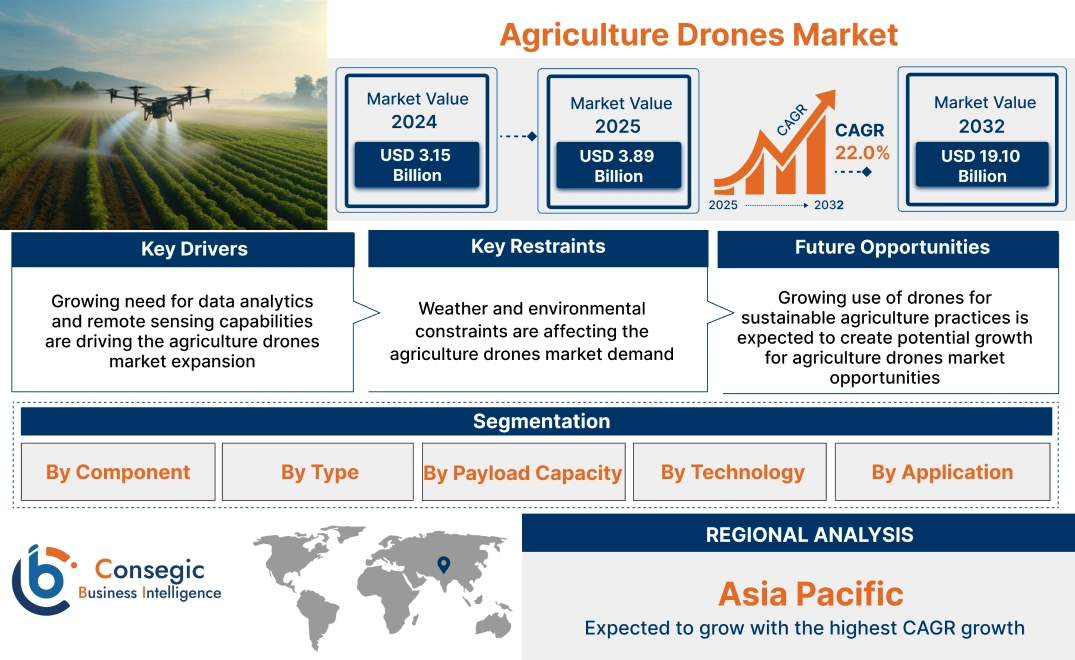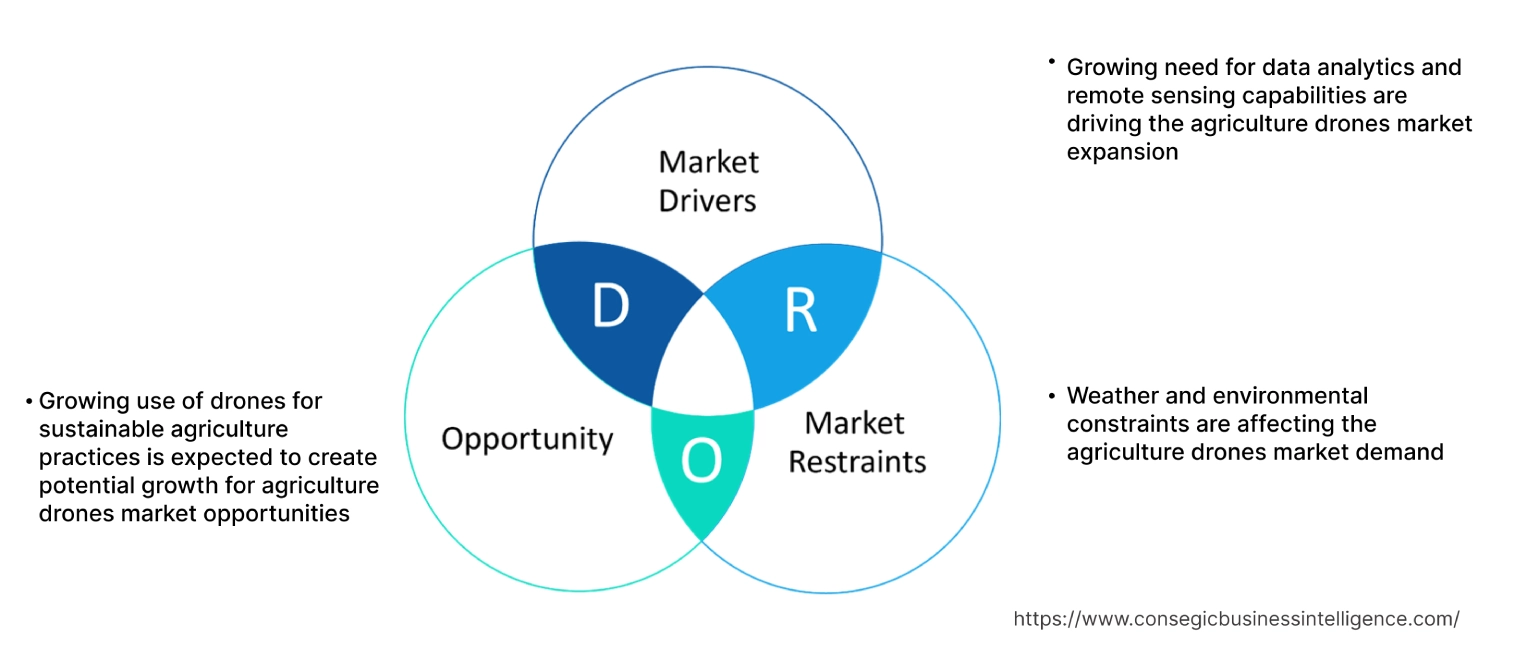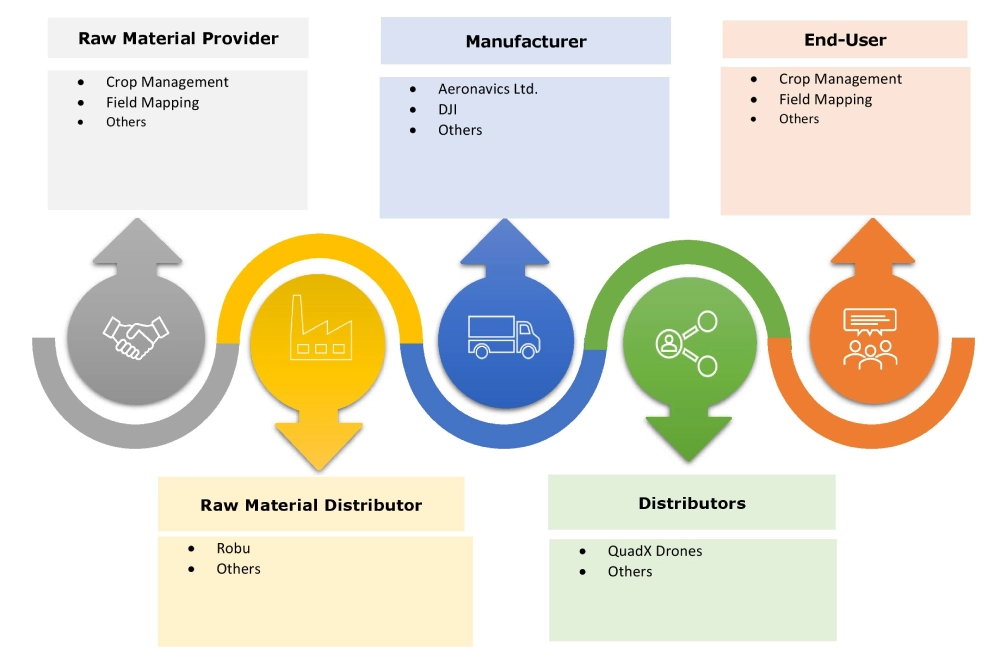- Summary
- Table Of Content
- Methodology
Agriculture Drones Market Size:
Agriculture Drones Market Size is estimated to reach over USD 19.10 Billion by 2032 from a value of USD 3.15 Billion in 2024 and is projected to grow by USD 3.89 Billion in 2025, growing at a CAGR of 22.0% from 2025 to 2032.
Agriculture Drones Market Scope & Overview:
Agriculture drones are equipped with cameras, imaging systems, and specialized sensors, allowing farmers to gather actionable data and insights about their crops and fields from above. These drones offer numerous benefits to farmers, including resource management, precision agriculture, and improved crop monitoring, leading to enhanced productivity, efficiency, and sustainability in farming operations. By leveraging drone technology, farmers can implement precision agriculture techniques, mitigate crop losses, and maximize yields in an increasingly challenging agricultural landscape.
Key Drivers:
Growing need for data analytics and remote sensing capabilities are driving the agriculture drones market expansion
With the advancements in drone technology, these unmanned aerial vehicles are equipped with sophisticated sensors and imaging systems, enabling them to capture high-resolution images and collect data on various agricultural parameters. This data, when combined with advanced analytics techniques, offers valuable insights into crop health, soil conditions, and environmental factors. Farmers can leverage this information to make informed decisions regarding irrigation, fertilization, pest management, and crop rotation, ultimately leading to improved yields and resource efficiency.
Further, remote sensing and data analytics enable precision agriculture practices, allowing farmers to tailor their interventions to specific areas within their fields. By precisely targeting inputs such as water, fertilizers, and pesticides, farmers can optimize resource usage, minimize waste, and reduce environmental impact. The ability to monitor crop health and detect anomalies in real-time empowers farmers to take proactive measures to mitigate risks and maximize productivity.
- For instance, in October 2022, DJI unveiled the Agras T40 drone, which was designed to streamline and accelerate crop spraying in fields, fruit trees, and orchards. The drone is equipped with advanced technology for precise and efficient application, which enhances operational activities for agriculture professionals.
Thus, according to the agriculture drones market analysis, the growing need for data analytics and remote sensing capabilities is driving the agriculture drones market size.
Key Restraints:
Weather and environmental constraints are affecting the agriculture drones market demand
Weather constraints significantly impact drone operations, posing significant challenges for industries that rely on aerial data collection and other services. Adverse weather conditions, such as high winds, rain, snow, and fog, can severely limit drone safety.
Drones, particularly those used for large-scale commercial applications, are often equipped with lightweight materials and are not designed to withstand harsh weather conditions. High winds affect the stability and control of drones, making it difficult to maintain precise direction of drones. Moreover, the performance of GPS and sensors used for navigation can also be compromised in areas with poor satellite coverage or in dense urban environments. Therefore, the above analysis depicts that the aforementioned factors would further impact the agriculture drones market size.
Future Opportunities :
Growing use of drones for sustainable agriculture practices is expected to create potential growth for agriculture drones market opportunities
The utilization of drones for sustainable agriculture practices represents a pivotal advancement in the global market. Aerial imagery captured by drones allows farmers to monitor the effectiveness of these practices and make informed decisions to promote soil health, biodiversity, and ecosystem resilience. Drones also support sustainable land management by enabling the identification of erosion-prone areas, monitoring of vegetation patterns, and assessment of land use changes over time. This information helps farmers implement erosion control measures, preserve natural habitats, and mitigate the negative impacts of land degradation. In addition to on-farm applications, drones contribute to sustainable agriculture by enabling more efficient and environmentally friendly agricultural operations.
- For instance, in April 2025, Vietnamese government initiated the digitalization in precision farming solutions under the allocation of mechanization and agricultural equipment. The initiative focuses on drones applications in rice farming, which will optimize production through advanced technology, particularly in rice direct seeding and fertilizer applications. This initiative seeks to increase rice production and farmer earnings while promoting environmentally friendly farming methods by incorporating advanced technologies such as drones into sustainable agricultural mechanization.
Thus, based on the above agriculture drones market analysis, the growing use of drones for sustainable agriculture practices is expected to drive the agriculture drones market opportunities.
Agriculture Drones Market Segmental Analysis :
By Component:
Based on component, the market is segmented into hardware, software, and services.
Trends in the component:
- The segment is expanding as drone technology enables companies to gather detailed insights that were previously difficult, costly, or dangerous to obtain. The ability to collect aerial data quickly and accurately is driving the need for drone-based solutions, offering new opportunities for businesses to make data-driven decisions.
- The versatility, agility, and cost-effectiveness of drones make them attractive solutions for agriculture industry seeking to enhance operational efficiency and data collection capabilities. As a result, there is a growing prospect for manufacturers, service providers, and technology developers to capitalize on expanding the agriculture drones market demand.
The hardware segment accounted for the largest revenue in the year 2024.
- Material science and engineering innovations are driving continuous improvements in drone hardware, resulting in lighter, stronger designs with enhanced capabilities like longer flight durations and greater payload capacity.
- The drone operations rely on controller systems, which act as the remote command center. These systems, encompassing flight controllers, navigation tools, and communication links, provide operators with real-time monitoring and control.
- Efficient, dependable, and responsive propulsion systems are crucial for agile drone flight and the ability to carry various payloads, including cameras, sensors, and agricultural equipment used for data acquisition and analysis.
- For instance, in February 2025, PDRL launched Ag++ flight controller for agricultural drones. Ag++ intends to make drone operations more efficient through easy integration, greater adaptability, and sophisticated sensor technology.
- Thus, based on the above developments, these factors are further driving the agriculture drones market growth.
The service segment is anticipated to register the fastest CAGR during the forecast period.
- The increasing adoption of drone-as-a-service (DaaS) is a key factor fueling the growth of the services sector within the agricultural drone market.
- By utilizing DaaS, farmers can hire specialized drone operators for tasks like field mapping, crop inspection, and spraying. This eliminates the need for farmers to develop drone operation expertise and guarantees access to accurate data and reliable services provided by experienced professionals.
- This service-based approach is particularly beneficial for smaller agricultural operations or areas with limited access to advanced technology, enabling them to leverage drone benefits without substantial upfront costs for equipment and training.
- For instance, in September 2024, PDRL launched SaaS platform, BhuMeet, to incorporate farmers and drone service providers. The platform will allow users to discover and hire drone service providers based on their service providers and proximity.
- Thus, based on the above analysis, these factors are expected to drive the agriculture drones market share during the forecast period.
By Type:
Based on type, the market is segmented into multi-rotor, fixed-wing, and others.
Trends in the type:
- Multi-rotor drones are commonly used in several applications, such as product delivery, surveying, and data acquisition & analytics, among others. The increasing technology and growing need for these drones in various industry verticals lead to cost-effective product development and growing availability.
- The integration of AI and cloud computing enables drone solutions to attain service accuracy and enhanced customer engagement.
The multi-rotor accounted for the largest revenue share of 58.55% in the year 2024.
- Multi-rotor drones are characterized by their versatility and agility, making it ideal for applications requiring close-range manoeuvrability and precise aerial control.
- These drones typically feature multiple rotors arranged in a symmetrical configuration, allowing for stable hovering, agile flight manoeuvres, and dynamic positioning in confined spaces.
- Multi-rotor drones are known for their ability to capture high-resolution aerial imagery, perform detailed inspections, and execute complex flight missions with ease.
- Thus, the above factors would further supplement the agriculture drones market share and trends.
The fixed-wing segment is anticipated to register the fastest CAGR during the forecast period.
- Fixed-wing drones are recognized for their endurance and long-range capabilities, making them ideal for applications requiring extensive area coverage and extended flight durations.
- These drones feature a fixed-wing airframe design, which enable efficient forward flight and sustained operation over vast distances.
- Fixed-wing drones are frequently utilized in industries such as precision agriculture, where the ability to cover large areas rapidly and collect data over extended periods is vital.
- These factors are anticipated to further drive the agriculture drones market trends during the forecast period.

By Payload Capacity:
Based on payload capacity, the agriculture drones market is segmented into lightweight drones (up to 10 kg), medium weight drones (up to 10kg - 25Kg), and heavy weight drones (above 25kg - 75Kg).
Trends in the payload capacity:
- Rising adoption of drones with high payload capacity for spraying agrochemicals over long distances, owing to its long-duration flight capabilities, and robust payload capacities.
- The miniaturization of drones, increasing need for battery efficiency and communication systems are enhancing the capabilities of lighter and medium drones, making them more user friendly and effective.
The medium weight drones (up to 10kg - 25Kg) segment accounted for the largest revenue share in the year 2024 and it is expected to register the highest CAGR during the forecast period.
- The medium weight drones segment is expected to experience significant growth due to the rising demand for drones capable of handling heavier payloads for medium to large-scale agriculture operations.
- Medium weight drones are equipped with multiple nozzles and intelligent spraying systems that adjust the application rate based on real-time data, reducing waste and environmental impact.
- Their ability to cover larger areas and operate in more complex environments makes them essential for businesses requiring increased efficiency and productivity.
- For instance, FIXAR offers FIXAR 025 model autonomous drone, which is designed to handle large-scale and long-range missions for industrial and commercial applications. The drone has the payload capacity of 10 kg, which has a load maintenance and easy-to-use.
- Therefore, the above factors are driving the global market trends.
By Technology:
Based on technology, the agriculture drones market is segmented into fully autonomous, semi-autonomous, and remote operated.
Trends in the technology:
- The integration of AI and cloud computing enables drone solutions to attain service accuracy and enhance customer experience.
- Increasing adoption of smart commercial drones across agriculture sector is fueling the market. Businesses are leveraging smart drones to gain actionable insights, improve productivity, and reduce costs in various operational areas.
The fully autonomous accounted for the largest revenue share in the year 2024.
- These agriculture drones can plan and execute to missions dynamically based on real-time data and environmental inputs, enabling farmers to operate with minimal supervision or intervention.
- These drones utilize sensor fusion techniques, advanced artificial intelligence (AI) algorithms, and machine learning models to perceive and respond to changes in the environment, optimize mission performance in real-time, and traverse obstacle.
- These drones enable farmers to optimize resource allocation, automate repetitive tasks, and improve decision-making in agriculture, leading to increased sustainability, efficiency, and productivity in farming operations.
- For instance, in February 2025, the Advanced Engineering School at Southern Federal University (SFedU) developed autonomous drones for precision agriculture application. The project includes robotics, AI, and agricultural science to develop effective solutions in precision farming.
- Thus, the above factors are driving the agriculture drones market growth.
The remote operated segment is anticipated to register the fastest CAGR during the forecast period.
- The proliferation of remote operated UAVs is driven by advancements in miniaturized sensor technology, improvements in flight autonomy and endurance, and the development of sophisticated data processing and analytics software.
- These drones fly at low altitudes, providing high-resolution imagery and detailed spatial information that are often inaccessible to satellites or manned aircraft.
- They offer rapid deployment and on-demand data collection capabilities, making them ideal for time-sensitive applications such as disaster response, emergency mapping, and environmental monitoring.
- These factors are anticipated to further drive the agriculture drones market trends and growth during the forecast period.
By application:
Based on application, the agriculture drones market is segmented into crop management, field mapping, crop spraying, livestock monitoring, smart greenhouse, data collection and analysis, irrigation management, agriculture photography, variable rate application (VRA), pest and weed detection, and others.
Trends in the application:
- The growing trend towards digitization and automation in the agriculture sector is driving the demand for drone analytics solutions. Farmers are leveraging drones solutions and services to streamline operations, enhance decision-making processes, and gain a competitive edge.
- Drones offer real-time aerial views of agriculture sites, enabling project managers to track progress, monitor safety, and ensure adherence to timelines. With drone technology, farmers can quickly assess site conditions, detect issues early, and evaluate the quality of the work being done, leading to better decision-making and resource allocation.
The crop management segment accounted for the largest revenue share in the year 2024 and it is expected to register the highest CAGR during the forecast period.
- Drones equipped with advanced sensors and imaging technologies enable farmers to gather real-time data on crop health, moisture levels, and pest infestations, empowering them to make data-driven decisions for precision agriculture practices.
- As extreme weather events become more common, farmers need to change their methods to reduce risks and maintain consistent harvests.
- Drones help by observing crops during severe weather, enabling farmers to evaluate damage and act quickly. This rapid response capability to shifting environmental conditions improves the ability of crops to withstand challenges and supports food security in a changing climate.
- For instance, in November 2023, DJI Agriculture showcased its latest drone solutions for farmers to enhance efficiency and quality of crops with advanced farming technology. DJI Agriculture provides a comprehensive crop protection system for farmers, offering drones designed for every stage of crop management, from surveying and mapping fields to spraying and spreading treatments. These advanced drones represent the cutting edge of agricultural technology, built to enhance both the efficiency and productivity of modern farming practices.
- Thus, based on the above factors, these developments are driving the global market.
Regional Analysis:
The regions covered are North America, Europe, Asia Pacific, the Middle East and Africa, and Latin America.
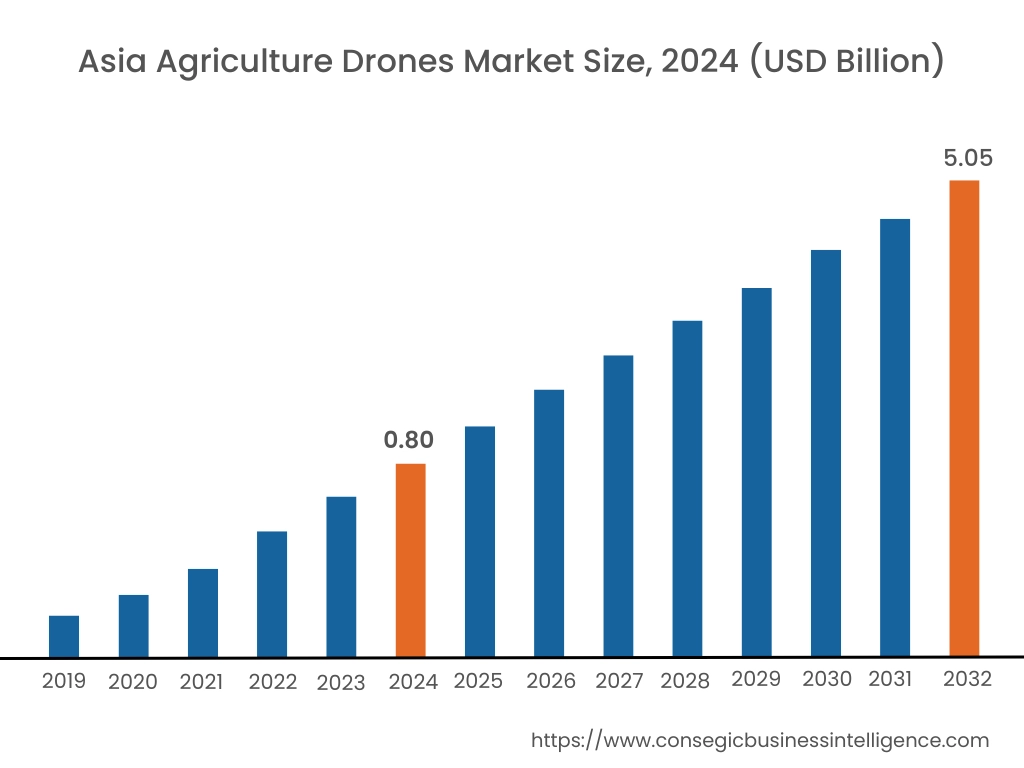
Asia Pacific agriculture drones market expansion is estimated to reach over USD 5.05 billion by 2032 from a value of USD 0.80 billion in 2024 and is projected to grow by USD 0.99 billion in 2025. Out of this, the China market accounted for the maximum revenue split of 34.99%. Government support and positive regulations that encourage the use of technology in farming are fueling market development. Several governments in the Asia Pacific region are introducing policies and programs to boost drone adoption, such as providing financial assistance, offering training, and establishing clear rules for drone operation. For instance, countries like China and India are actively encouraging the incorporation of drones in agriculture to enhance efficiency and environmental sustainability, thereby fostering a favorable environment for agriculture drones. These factors would further drive the regional market during the forecast period.
- For instance, Indian Government has introduced sub-mission on agricultural mechanization (SMAM), to provide financial aid to farmers who purchase drones. This initiative expands the access of agricultural machinery to small-scale and resource-poor farmers, particularly in areas where there is a shortage of farm power.
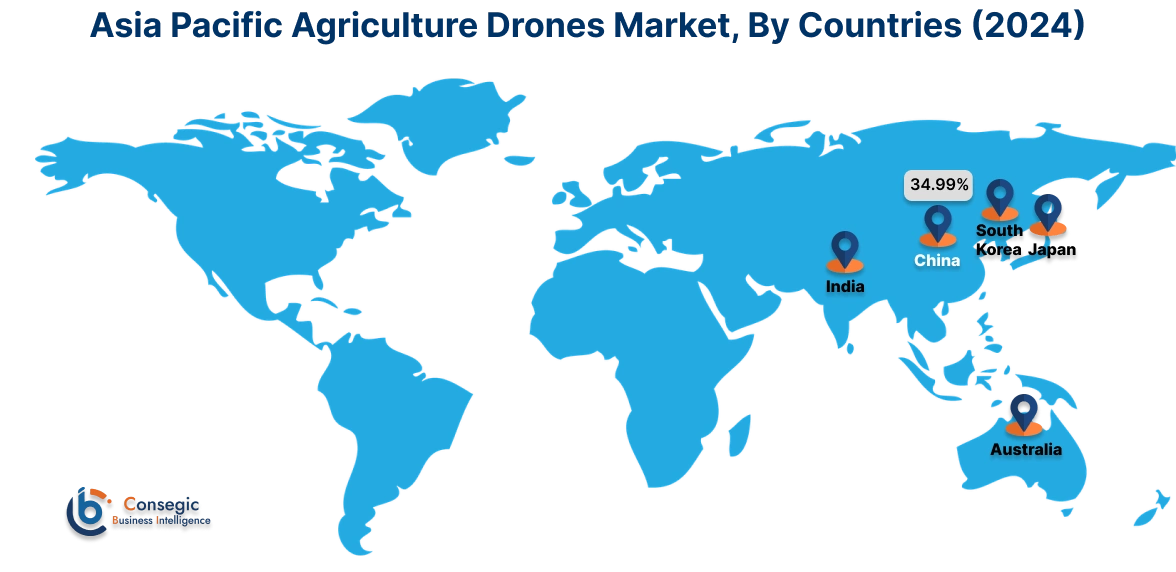
North America market is estimated to reach over USD 6.89 billion by 2032 from a value of USD 1.14 billion in 2024 and is projected to grow by USD 1.41 billion in 2025. The increasing adoption of remote sensing technologies is significantly driving the agriculture drone market. Drones equipped with diverse sensors, like multispectral and thermal cameras, allow farmers to collect comprehensive data about their crops aerially. These remote sensing tools facilitate the monitoring of plant health, soil moisture, and nutrient imbalances, offering insights that were previously hard to acquire. As more farmers utilize these technologies to improve their monitoring abilities, the demand for agricultural drones is expected to rise. These factors would further boost the agriculture drones market in the region.
- For instance, in April 2024, DJI Agriculture announced the global release of drones Agras T50 and T25. The T50 offers excellent efficiency for large -scale agricultural operation, while the T25 drone is designed for greater tolerance and suitable for small fields. Both drones are integrated with improved smart farm applications to provide reliable and comprehensive drone management.
Additionally, according to the analysis, the agriculture drones industry in Europe is anticipated to witness significant development during the forecast period. Countries within the European Union prioritize renewable energy technologies and promote the adoption of solar-powered UAVs for various agriculture applications. European contractors and research institutions collaborate on projects aimed at developing advanced UAV systems capable of addressing environmental challenges.
Additionally, the Latin American market growth can be attributed to the rising utilization of agriculture drones in several applications, including mapping, surveying, crop management, crop scouting, and surveillance among others. Additionally, the growing need for drones in the agriculture applications in the Middle East & Africa, such as progress monitoring, 3D modeling and mapping, land surveying, and waste reduction, is propelling the regional market progression. Further, drones enable real-time insights, aid in workforce planning, and foster collaboration, without disrupting operations. Thus, based on the above market analysis, these factors would further drive the regional market during the forecast period.

Top Key Players and Market Share Insights:
The global agriculture drones market is highly competitive with major players providing products to the national and international markets. Key players are adopting several strategies in research and development (R&D), product innovation, and end-user launches to hold a strong position in the market. Key players in the agriculture drones industry include-
- Parrot Drone SAS (France)
- AeroVironment Inc. (U.S.)
- DJI (China)
- PrecisionHawk Inc. (U.S.)
- Hiphen (France)
- DroneDeploy (U.S.)
- Autel Robotics (China)
- Draganfly (Canada)
- Pix4D SA (Switzerland)
- Sky-Drones Technologies Ltd (U.K.)
Recent Industry Developments :
Collaborations and Partnerships:
- In February 2023, XAG announced the partnership with Farmlno, to bring autonomous agricultural drones to Thailand. The partnership will lead to the launch of autonomous drones with intelligent control systems. The drones are fully autonomous and powered by AI, which are ideal for spreading and precision spraying.
Agriculture Drones Market Report Insights :
| Report Attributes | Report Details |
| Study Timeline | 2019-2032 |
| Market Size in 2032 | USD 19.10 Billion |
| CAGR (2025-2032) | 22.0% |
| By Component |
|
| By Type |
|
| By Payload Capacity |
|
| By Technology |
|
| By Application |
|
| By Region |
|
| Key Players |
|
| North America | U.S. Canada Mexico |
| Europe | U.K. Germany France Spain Italy Russia Benelux Rest of Europe |
| APAC | China South Korea Japan India Australia ASEAN Rest of Asia-Pacific |
| Middle East and Africa | GCC Turkey South Africa Rest of MEA |
| LATAM | Brazil Argentina Chile Rest of LATAM |
| Report Coverage |
|
Key Questions Answered in the Report
How big is the Agriculture Drones Market? +
Agriculture Drones Market Size is estimated to reach over USD 19.10 Billion by 2032 from a value of USD 3.15 Billion in 2024 and is projected to grow by USD 3.89 Billion in 2025, growing at a CAGR of 22.0% from 2025 to 2032.
Which is the fastest-growing region in the Agriculture Drones Market? +
Asia-Pacific is the region experiencing the most rapid growth in the market.
What specific segmentation details are covered in the Agriculture Drones report? +
The agriculture drones report includes specific segmentation details for component, type, payload capacity, technology, application, and region.
Who are the major players in the Agriculture Drones Market? +
The key participants in the market are Parrot Drone SAS (France), AeroVironment Inc. (U.S.), DJI (China), PrecisionHawk Inc. (U.S.), Hiphen (France), DroneDeploy (U.S.), Autel Robotics (China), Draganfly (Canada), Pix4D SA (Switzerland), Sky-Drones Technologies Ltd (U.K.), and others.
